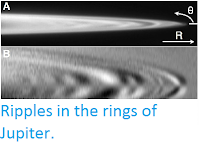Until this month Jupiter was known to have sixty seven moons, split into three separate groups. Firstly their are the four large Galilean Moons discovered by Galileo Galilei in January 1610, which are larger than both Earth's Moon and the planet Mercury, and which orbit in the same direction and plane as the planet rotates. Secondly their are the smaller prograde moons, which also orbit in the same plane and direction as the rotation of the planet; these are split into two groups, the four Inner Moons, which orbit inside the orbits of the Galilean Moons, and the larger group of Himalian Moons, which orbit outside (and take their name from the moon Himalia, the largest member of the group). Finally there are the retrograde moons, which orbit some way outside the prograde moons, in roughly the same plane but in the oposite direction, split into three distinct families, Carme, Ananke, and Pasiphae, which are thought to have derived from three separate parent moons which broke up at some time in the remote past.
On 16 June 2018 a team led by Scott Shepard of the Carnegie Institution for Science, announced the discovery of twelve new moons of Jupiter, discovered by the Cerro Tololo Inter-American Observatory on Chile between 2016 and 2018.
Two of these moons, S/2017 J4 and S/2018 J1 (designations which imply the forth Jovian Moon discovered in 2017 and the first discovered in 2018) are placed within the Himalian Group. Four, S/2017 J7, S/2016 J1, S/2017 J3, and S/2017 J9, are placed within the Anake Group, two, S/2017 J6 and S/2017 J1, are placed within the Pasiphae Group, while three more, S/2017 J5, S/2017 J8 and S/2017 J2, are placed within the Carne Group. The final new discovery, S/2016 J2, however, is distinct from any previously discovered population of Jovian Moons, with a prograde orbit tilted at an angle of 34° to the plane of the Jovian system, and outside the orbit of the Himalia Group, on an orbit that overlaps that of the Retrograde Moons. This orbit is so distinctive that the moon has been given a provisional formal name, Valetudo (after a great grandaughter of the Roman god Jupiter).
Illustration showing the newly discovered moon (in green). Roberto Molar Candanosa/Carnegie Institute.
S/2016 J2 Valetudo orbits Jupiter at an average distance of 18 938 000 km (roughly fifty times the distance at which our Moon orbits the Earth), and is about a kilometre in diameter.
Recovery images of Valetudo from the Magellan Telescope in May 2018.
The moon can be seen moving relative to the steady state background of
distant stars. Jupiter is not in the field but off to the upper left. Carnegie Institute.
See also...
Follow Sciency Thoughts on Facebook.








